For one of our assignments, we had to make a political party broadcast for the Scottish Green Party, enjoy!

Design and Innovation of Healthcare Systems
Scotland Study Abroad Program 2022
For one of our assignments, we had to make a political party broadcast for the Scottish Green Party, enjoy!
I have a very love-hate relationship with the 3D modeling software we used for this class. When you’ve stared at it long enough, you start thinking about extrusions and filleting edges when you’re walking around the city, just looking at architecture. But when it works and you create a detailed 3D model from scratch, it’s an incredibly satisfying feeling. For my technical assignments, I modeled my Chapstick and a golden snitch from Harry Potter- here’s a few snapshots into my process of developing these models.
Chapstick

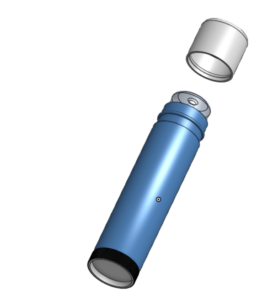
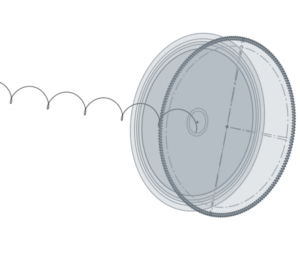
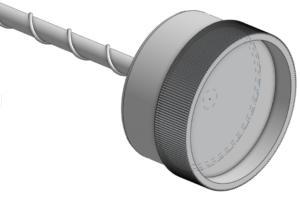
_________________________________________________________
Golden Snitch (with some artistic license)
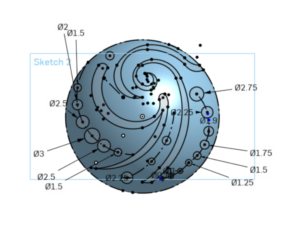
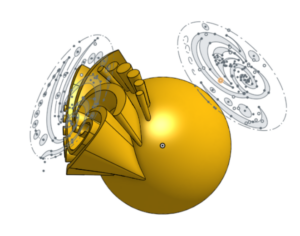
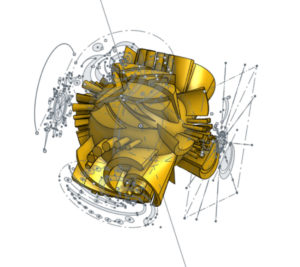
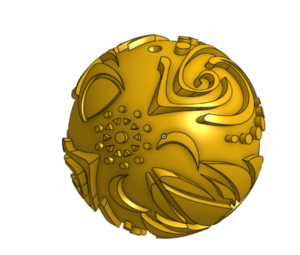
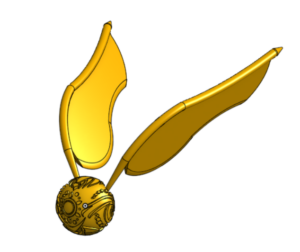
And here’s the finished project! Definitely a lot of work, but I learned a lot of new tools that I can use later on. And a personal Snitch model that I can 3D print at some point!
One of my favorite experiences during this study abroad session was the opportunity to visit the V&A museum in Dundee. If you’re not familiar, the V&A was the first design museum in Scotland and stands for the Victoria and Albert Museum, named after Queen Victoria and Prince Albert.
We first visited the V&A for class our first week in Scotland (while we were in Dundee), but I first noticed the building while on our tour bus the first day because of the architecture of the building. When we went in, we talked about the design of the building itself, similar to the inside of a ship with a floor made of limestone that contained real fossils. Our class visited the V&A specifically for the Biomedical Engineering aspect and since we are taking a design class, the museum fit in perfectly with our curriculum.
Earlier in the week, we had a guest lecturer that talked about realistic healthcare and medicine, as well as Maggie Centers. We talked about how to design a healthcare system based on people and how we can improve the experiences and quality of services, both for patients and healthcare workers. The museum’s design section that we visited featured a model of one of the Maggie Centers, the design process behind it, and the future for these projects. They also had a free book reading section and I read a book on the importance of playgrounds and greenery in cities for children’s mental and physical health. Other exhibits featured sustainable and recyclable materials for building and city design and other design processes throughout the years in Scotland. These exhibits made me hopeful for the future of our cities and care design.
What stuck with me the most, from both our guest lecture and the V&A were the topic of realistic medicine, playground importance, and Maggie Centers. One of the reasons I applied for this study abroad is not because I am studying Biomedical Engineering, I am a public policy and environmental justice major (which is why I found the playground and sustainability fascinating) with a heavy interest in health policy, equity, environmental health, and access.
For my first year and a half at UNC, I avoided going into areas of my major that featured only health policy and insurance. My family has had quite a bit of experience with the American healthcare system and insurance since both of my parents had cancer. Healthcare was a sore subject for me but one that I kept falling back into with environmental justice/health and public health classes I took this past year. When I saw this program, I knew immediately that all of my classes and time at UNC led me to apply and I haven’t regretted it for a second.
Learning about the Scottish healthcare system and goals for the future has been a breath of fresh air for myself and has helped me realize where I want to focus my studies and look for in a career. The Maggie Centers in particular is something that I want to bring back home. It’s been four weeks since we have talked about these centers, but the class discussion and trip to the V&A have been a thought in the back of my head (and written on a lot of sticky notes). I am grateful that this program helped me learn about new aspects of healthcare systems and design, and while it may not be the typical route that many of our students will follow, this museum and experience is one that I won’t be forgetting any time soon.
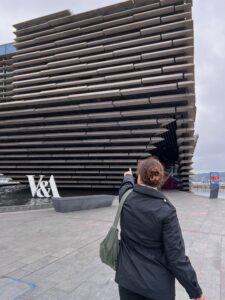
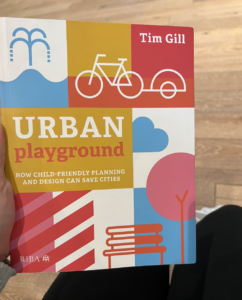
Pictured Above: Me and the V&A and the book I strongly recommend reading
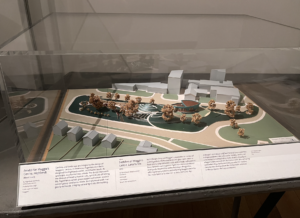
Pictured Above: The Maggie Center Model
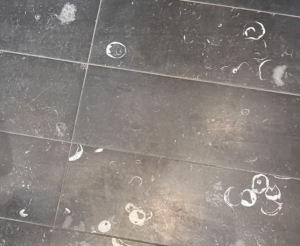
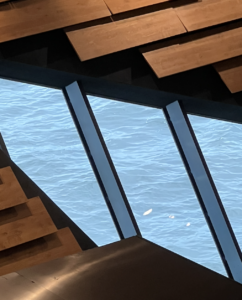
Pictured Above: the limestone floor and window of the water inside
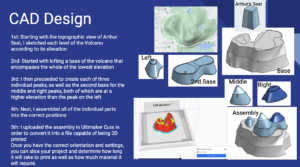
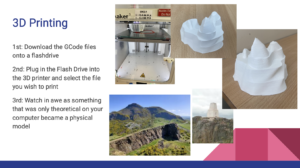
For the technical module project, I created a replica of the Loch Ness Monster inspired by our trip to Loch Ness. This expedition was one of my favorite experiences abroad. It was a warm and sunny morning, and we spent the day hiking, sightseeing, and getting to know one another. My 3D figure is a memento of the start of my abroad journey and all the good memories to come.
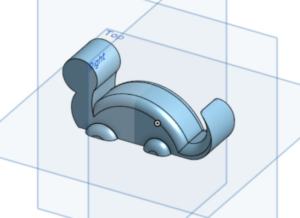
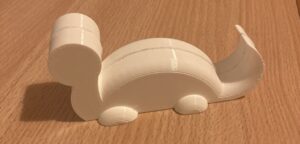
(To the left is my OnShape model design and to the right is the 3D printed model)
For my technical module project, I was inspired by our visit to Swanston Farm in Howe, Edinburgh, where we got to see highland cows up close! The highland “coos” are iconic to Scotland, and with my matching hair color and style, it seemed only fitting that I use this project to create my own little replica. In Onshape, I sketched and extruded the outline of my model, and, on top of that sketch, I added extra detail, including my cow’s fur and nose, the cross from the Scotland flag, and Edinburgh lettering on the left horn. I chose to laser cut my model because I wanted more precise cuts for the finer detail of my sketch. I also decided to laser cut out of blue acrylic, which would play off of the cross detail and serve as a nod to the Scottish flag. Attached below are my Onshape models, finished design, and photo inspirations!
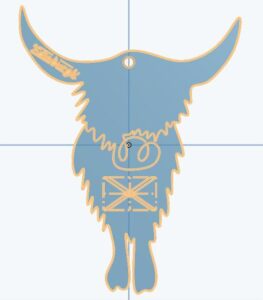
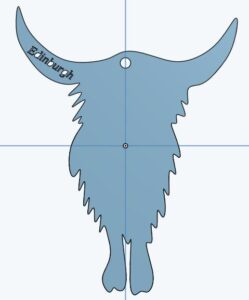
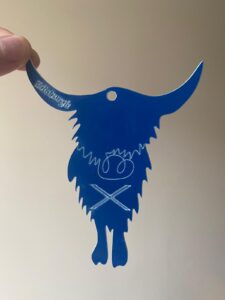

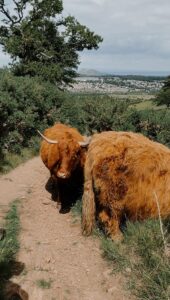
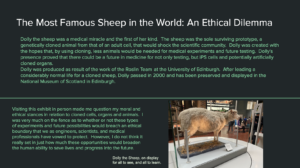
For my technical module 3D printing assignment, I created a gold ring on onshape with “Loch Ness” printed inside. One of my favorite experiences in Scotland so far was visiting Loch Ness. The Hobbit is also one of my favorite books and with all of the inspiration in Scotland I have seen throughout the book and because I love rings, this is what I made. It’s simple (which is my personal jewelry style), and matches the replica of a “the one ring to rule them all”, at least color wise and shape wise. I chose Loch Ness to engrave, instead of Hobbit inspired words. I am happy that I have something that I can physically wear and be reminded of my time here, both in the makerspace and at Loch Ness.
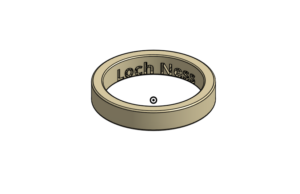
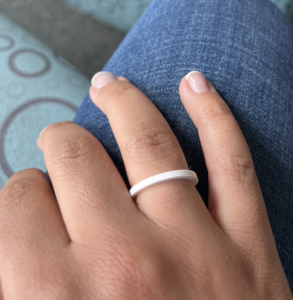
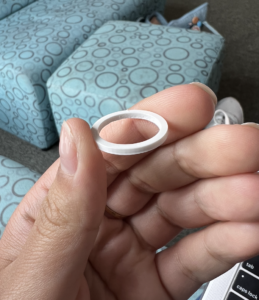
On Tuesday, June 28th, Sydney Schwartz and I visited the Surgeons’ Hall Museum in Edinburgh, Scotland. While we were interested in different exhibits, we both found the museum (as a whole) to be fascinating and incredibly eye-opening. The tour started in a central room that showcased tools used for surgeries dating back to the early 18th century (wow; we advanced in technology and innovation!). In the central room, many tumors and organs with abnormalities and several cadavers were on display. Two cadavers were the remains of children whose bodies were donated to science in 1702 and 1718 and were also the oldest in the museum’s collection. The cadaver from 1718 was dissected by Alexander Munro Primus, the first professor of anatomy at the Edinburgh University medical school.
One of the most interesting displays was a plaster cast of Robert Penman’s lower jaw tumor. While the tumor needed to be removed for Penman to sustain life (as he could not eat or drink due to the size of the tumor), the surgery was performed prior to the availability of effective anesthesia. Nonetheless, the surgery, performed by Dr. James Syme in 1828, was a success!
My favorite part of this museum visit was the dental surgery section. I especially enjoyed learning about early dental practices, particularly impression techniques. As one museum label explains, a dental impression is a negative imprint of teeth and mouth tissues that is used as a mound to make a positive cast. The tray on display would have been filled with soft material, like beeswax or plaster of Paris, to make the impression, as alginates or irreversible hydrocolloids had not yet been discovered as an effective/practical material.
The museum also featured modern technology and explained how it has improved healthcare. For example, biomedical engineering is an integral part of modern dentistry as virtual depictions of the jaw enable maxillofacial surgeons, dentists, and orthodontists to visualize vantage points inside their patient’s mouths for better accessibility.
The Surgeons’ Hall Museum was one of the highlights of my trip to Edinburgh. I would encourage anyone interested in medicine, healthcare, or technology (including biomedical engineering) to visit! No matter your specific curiosity, there is an exhibit in the museum sure to challenge your way of thinking concerning healthcare or the advancement of modern medicine.
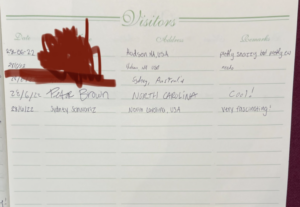
Our signatures in the visitors log
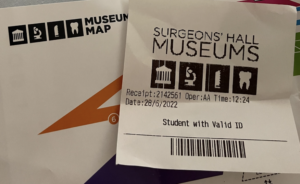
My ticket and museum brochure
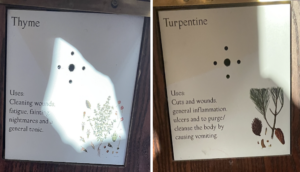
Early uses of natural remedies!
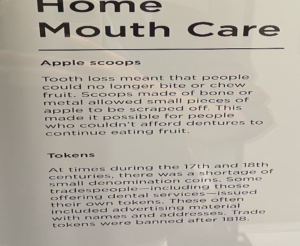
Interesting description about the limitations of missing teeth!
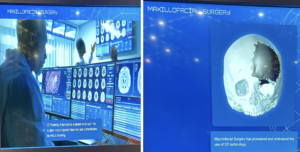
How biomedical engineering is used in Maxillofacial Surgery!
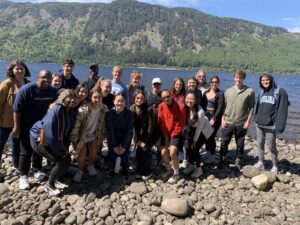
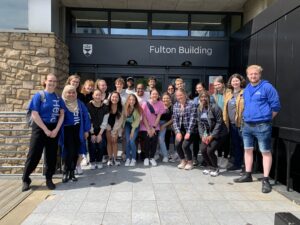
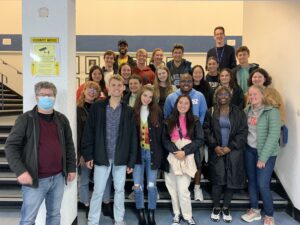

Top Left: Group photo at Loch Ness! Anyone spot Nessie?
Top Right: Group photo after a tour of the University of Dundee, Dr. Donnelly’s alma mater!
Bottom Left: Group photo at the University of Dundee, after touring the School of Science and Engineering Centre for Anatomy and Human Identification to look at the Thiel Embalmed Cadavers
Bottom Right: Some students in Dunkeld taking a pit stop by the river